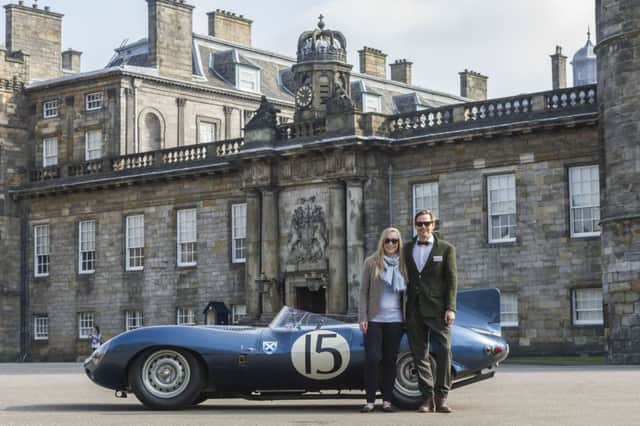Rise and fall of Scots racing team Ecurie Ecosse


It is fitting this should be in Edinburgh as it was here in 1951 that a local businessman, the remarkable but enigmatic David Murray, founded the iconic racing team. It must have been outwith the bounds of even Murray’s imagination that, within five years, his small low-profile team would have won the world’s premier endurance racing event, Le Mans 24 hours, not once but twice in a row, in 1956 and 1957. Edinburgh’s Ron Flockhart , a Stewart’s FP,was the winning driver both times with Ninian Sanderson from Glasgow as co-driver in 1956. Sanderson would also secure 2nd place for the team in 1957 with Jock Lawrence from Cullen as co-driver. The Jaguar D type they drove will be on show at the Concours.
Murray created his team on a shoestring budget in two lock-ups in Merchiston Mews and their victories were the first by a non-works team since the race’s inception in 1924. To achieve this, the “big beasts” of Ferrari, Porsche, Mercedes, Aston Martin and the like had to be overcome.
Advertisement
Hide AdAdvertisement
Hide AdDavid v Goliath does not come into it. The outlandish scale of the achievement, would, in football terms, be akin to, say, Dumbarton winning the Champions League, twice, consecutively.
Yet, 12 years later Murray was to leave Edinburgh clandestinely for the Canaries under the cloud of bankruptcy. He slipped out of the country leaving his affairs in a complete tangle with only his wife and lawyer aware of his destination, presumably chosen as there was then no extradition possible from there. Four years later, aged 63, he died after a heart attack in Las Palmas following injuries sustained in a car accident, a cruel irony. By then nothing had been heard of him since he left Edinburgh and he had become a forgotten man.
Murray, pictured, had a comfortable upbringing in a large house in Wilton Road, Newington and attended the city’s Royal High School, where he showed his promise by becoming head boy and captain of the rugby and cricket teams. Qualifying as an accountant, he followed in his father’s footsteps by diversifying into the licensed trade. He continued playing rugby for the FPs, being a member of the team that shared the 1934 Scottish championship, representing Edinburgh, playing in a Scottish trial, and, once, reserve for the national team.
After moving to London in the late 1930s his interest in motor racing began to take off. Rugby with London Scottish took a back seat as he became a regular at Brooklands in Surrey, the world’s first purpose-built circuit. There among the glitz and excitement of the Bentleys, Bugattis and Alfa Romeos he became hooked.
After the war he started racing Maseratis, winning an international road race in Copenhagen in 1949 and competing in Holland, Italy, Spain and Switzerland. However, following a crash at Nürburgring in 1951, he retired.
He then focussed on his ambition to set up a Scottish racing team, facilitated by his now owning a garage in Merchiston Mews, which specialised in high performance cars. Although prosperous, he needed investment and astutely persuaded Esso to provide £5,000 for the project.
The owners of three Jaguar XK 120s then agreed to come on board and, over dinner at the Café Royal in late 1951, the deal was struck with Ian Stewart, Bill Dobson and Sir Jamie Scott-Douglas becoming the team’s first drivers. The name was Murray’s idea and was a masterstroke as it attracted attention and suggested glamour.
The dual Le Mans success was undoubtedly the high point of his achievements at Ecurie Ecosse. A fan club was formed with over 2,000 members from 39 countries and a monthly magazine was produced News from the Mews.
Advertisement
Hide AdAdvertisement
Hide AdMurray and his wife Jenny became popular socialites, regularly throwing lavish parties at their elegant Cambridge Terrace flat overlooking Edinburgh Castle. The team’s reputation continued to attract top drivers for a while, including Innes Ireland, Jackie Stewart and, once, Jim Clark but on the track there were diminishing returns.
By 1962 Murray was hinting at financial problems in keeping the team afloat and, throughout the decade, those difficulties mounted. Creditors sued him for debt but he weathered one crisis after another until, in late 1969, he was made bankrupt. His examination in court was fixed for 29 December but, days before that, he fled, leaving a number of unanswered questions. Although insolvent, it was reckoned that, with the assets he owned, a solution could have been reached.
Speculation was rife, particularly about his private life. Ian Stewart remarked, “He led a fairly fast and loose life”. Some thought blackmail may have been involved.
Murray and his wife lived frugally in a small flat in Las Palmas where he worked in a bar and helped out in an accountant’s office. While driving to work in his old Mini, he collided with a bus and was taken to the Queen Victoria Hospital where he died after a heart attack on 5 April 1973.
Jackie Stewart recalled: “He was my early mentor. I couldn’t have asked for a better introduction to the big time.”
Murray was popular and charming and his contribution to motorsport here was immense. He and his wife have a bench dedicated to them by friends, near their old flat.
l The 2015 Concours of Elegance takes place from 4-6 September at the Palace of Holyroodhouse in Edinburgh.